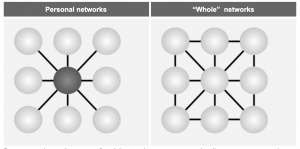Personal vs “Whole” Networks
Please sign in or create your account in order to access this material.
 Social ties within a network can be viewed through a personal or whole network lens. Most research on the social connection has examined self and personal networks, meaning the personal friendships or other significant relationships reported by a study participant. For example, a person in a group is asked to rate everyone else in their group. However, social modelist think in terms of whole networks and are interested in the relationships of named individuals with each other. For example, asking an individual to rate all the others and asking the others to rate the individual. This is more reflective of social model philosophy.
Social ties within a network can be viewed through a personal or whole network lens. Most research on the social connection has examined self and personal networks, meaning the personal friendships or other significant relationships reported by a study participant. For example, a person in a group is asked to rate everyone else in their group. However, social modelist think in terms of whole networks and are interested in the relationships of named individuals with each other. For example, asking an individual to rate all the others and asking the others to rate the individual. This is more reflective of social model philosophy.
Course Syllabus
Not Enrolled
| .1. Opposite of Addiction is Connection | ||
| .2. Social Determinants of Health | ||
| .2.1. SDOH vs. Medical Model | ||
| .2.2. Healthy People 2030: SDOH | ||
| .3. Social Model Ecosystems | ||
| .3.1. Ecosystem Stability | ||
| .3.2. Social-Community Model | ||
| .4. Sense of Community | ||
| .4.1. Perceived Sense of Community Scale | ||
| .4.2. Brief Sense of Community Scale | ||
| .5. Social Networks | ||
| .5.1. Abstinence-Specific Social Support | ||
| .5.2. Multiple Group Membership | ||
| .5.3. Multiple Dimensional Networks | ||
| .5.4. Personal vs "Whole" Networks | ||
| .5.5. Beneficial Characteristics of Social Networks | ||
| .5.6. Health Benefits of Social Networks | ||
| .6. Social vs Clinical Model | ||
| .6.1. Environment | ||
| .6.2. Staff | ||
| .6.3. Authority | ||
| .6.4. Recovery Orientation | ||
| .6.5. Governance | ||
| .6.6. Community Orientation | ||
| .7. Quiz: Social Model |
